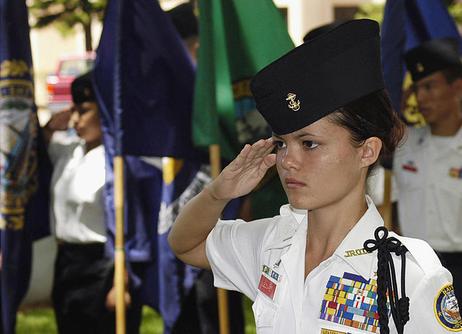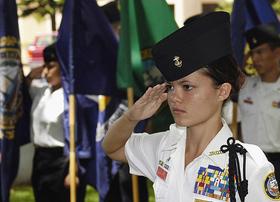Junior Reserve Officers Training Corps or JROTC
I was disappointed to read the story in the about abuse in an Army JROTC program. Why? Because I've always thought very highly of the program available in over 1700 public and private high schools. I will further disclaim that my eldest daughter was in the ROTC program at MIT while she was at Harvard. So, I know first-hand that it is well-run for the most part. The JROTC does an immense amount of good for young people at the high school level.
This photo generated by Canva shows JROTC cadets in their formal uniforms.

What is JROTC?
or Junior Reserve Officers Training Corps in 1916. Each branch of the services has its own distinctive JROTC program. However, they all have the altruistic-sounding mission "To Motivate Young People to be Better Citizens."
The U.S. Army Junior Reserve Officers’ Training Corps (JROTC) is one of the largest character development and citizenship programs for youth in the world. Source:
- Some people think that JROTC is a recruiting program for the military.
- But it is not. Indeed, most JROTC participants do not join the military after graduating from high school.
- Nor are they required to do so.
- On the other hand, the college-level ROTC programs do require their participants to sign up for a tour of duty after graduating from college.
- Simply put, the JROTC aims to develop leadership skills in its participants while ROTC prepares its members for the military.
This video explains what JROTC is.
The Air Force JROTC
There are approximately 870 AFJROTC units with more than 125,000 cadets in high schools across the United States and selected Department of Defense Dependent Schools in Europe, the Pacific, Puerto Rico, and Guam. Source:
The seeks to develop academic skills, confidence, and leadership skills to equip young people to be the leaders 21st-century society needs them to be.
- Over 125,000 high schoolers are active in the Air Force program in 870 schools worldwide. Worldwide?
- Yes, worldwide, because the Department of Defense has DOD schools wherever there is a military base.
- One unique feature of the Air Force JROTC program is its .
- This 8-week-long program offers the ability to earn a Private Pilot Certification. At a time when airlines need pilots, this is a solid start to a lucrative, satisfying career.
This video, taken by a student, offers a look at the .
The Navy JROTC
The NJROTC program was established by Public Law in 1964 which may be found in Title 10, U.S. Code, Chapter 102. Source:
- As noted, Congress established almost 50 years after the Army's program. Like its Air Force and Army cousins, the Navy JROTC program emphasizes the development of its participants.
- The Navy's JROTC summer programs vary depending on the high school sponsoring them. Typical summer programs or "camps" include a , and more.
The Marines JROTC
The effects of the Marine Corps JROTC program reach far beyond the classroom and into the community in developing character, leadership, and civic responsibility in tens of thousands of America's kids. Source:
This video offers a look at the .
As I researched the three JROTC programs, I was struck by the unified approach they all take toward developing the leadership and academic skills of their young participants.
Who teaches JROTC programs?
- You might think that active-duty military personnel teach JROTC courses.
- But that's not the case. Instructors are retired military officers, for the most part.
Who pays for JROTC programs?
- If a school requests a JROTC program, the military service involved will fully fund the program.
- On the other hand, when a school prefers to fund its own cadet training program, that program is styled the National Defense Cadet Corp.
Valuable supplemental programs
The military JROTC programs offer young people the opportunity to explore academic programs, become part of a team, and develop an awareness of what it means to be an American citizen.
- In addition, JROTC programs teach leadership skills and build confidence, all attributes that benefit young people in their adult lives.
- Best of all, JROTC programs are available to students in the 8th grade and up from every socio-economic level.
Approximately 40% of JROTC programs are in inner-city schools, serving a student population of 50% minorities. Source:
Pros and Cons
Pros
- JROTC programs are unique. In other words, the JROTC program at one high school is different from the program in other schools. It all depends on the instructors, the students, and the school.
- The program costs its participants nothing. Even uniforms are provided.
- Participants have to be in good academic standing.
Cons
- Corps members have to abide by appearance standards.
- The physical training can be demanding.
Service academy nominations
- Now, while the purpose of JROTC programs is to educate and develop young people as opposed to recruiting them for military service, young people who rise to the top of their school's JROTC program do have the opportunity to be nominated for the prestigious military academies.
- But unfortunately, nomination to the service academies is a complicated process, with many more applicants competing for a limited number of places.
- Read more about it at on the White House website.
Conclusion
JROTC programs offer valuable lessons in leadership and a host of other attributes for high school-age young people. This quote from a cadet in Ola High School in McDonough, Georgia, says it eloquently:
"You cannot control what happens to you, but you can control your attitude toward what happens to you, and in that, you will be mastering change rather than allowing it to master you." ~Brim Tracy~Cadet Marshall 2011
Questions? Contact us on Facebook, Instagram, and YouTube. @publicschoolreview
#publicschools #JROTC #militaryservice















